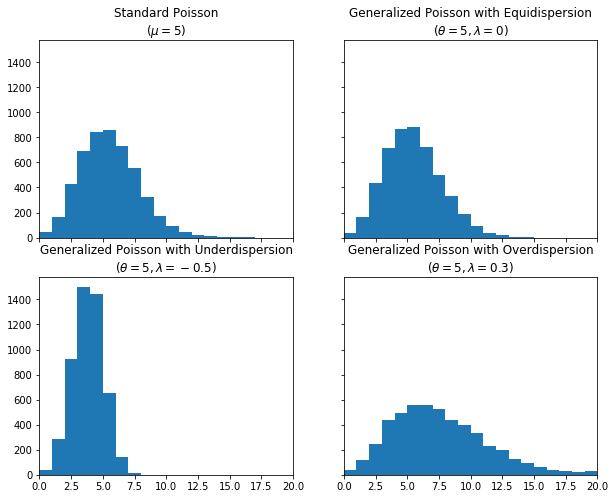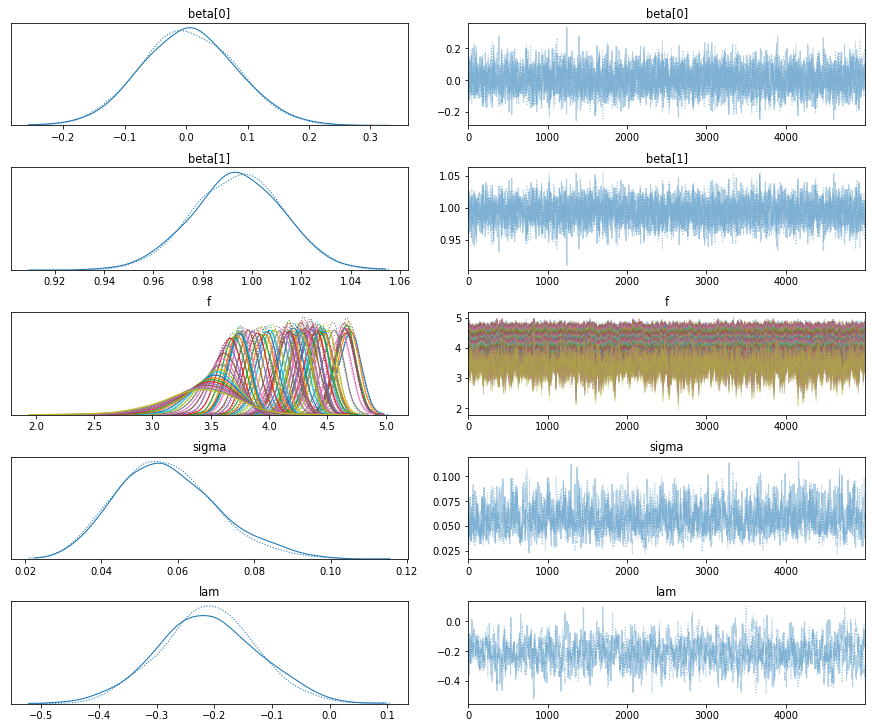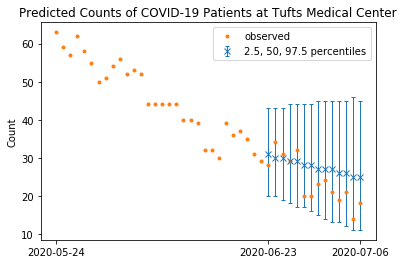Defining a Custom Distribution in PyMC3¶
In this notebook, we are going to walk through how to create a custom distribution for the Generalized Poisson distribution.
There are 3 main steps required to define a custom distribution in PyMC3:
Define the log probability function
Define the random generator function
Define the class for the distribution
Background on the Generalized Poisson¶
The Poisson distribution models equidispersed count data where the mean \(\mu\) is equal to the variance. $\(p(Y = y | \mu ) = \frac{e^{-\mu} \mu^y}{y!}\)$
The Negative Binomial distribution allows us to model overdispersed count data. It has 2 parameters:
Mean \(\mu > 0\)
Overdisperson parameter \(\alpha > 0\)
As \(\alpha \rightarrow \infty\), the Negative Binonimal converges to the Poisson.
The Generalized Poisson distribution is flexible enough to handle both overdispersion and underdispersion. It has the following PMF:
where \(\theta > 0\) and \(\max(-1, -\frac{\theta}{4}) \leq \lambda \leq 1\)
The mean and variance are given by $\(\mathbb{E}[Y] = \frac{\theta}{1 - \lambda}, \quad \text{Var}[Y] = \frac{\theta}{(1 - \lambda)^3}\)$
When \(\lambda = 0\), the Generalized Poisson reduces to the standard Poisson with \(\mu = \theta\).
When \(\lambda < 0\), the model has underdispersion (mean \(>\) variance).
When \(\lambda > 0\), the model has overdispersion (mean \(<\) variance).
import os
from datetime import date, timedelta
import matplotlib.pyplot as plt
import numpy as np
import pandas as pd
import pymc3 as pm
import theano.tensor as tt
from pymc3.distributions.dist_math import bound, factln, logpow
from pymc3.distributions.distribution import draw_values, generate_samples
from pymc3.theanof import intX
1. Log Probability Function¶
The \(\log\) of the PMF above is as follows:
where \(\theta > 0\) and \(\max(-1, -\frac{\theta}{4}) \leq \lambda \leq 1\)
We now define the log probability function, which is an implementation of the above formula using just Aesara operations.
Parameters:
theta: \(\theta\)lam: \(\lambda\)value: \(y\)
Returns:
The log probability of the Generalized Poisson with the given parameters, evaluated at the specified value.
def genpoisson_logp(theta, lam, value):
theta_lam_value = theta + lam * value
log_prob = np.log(theta) + logpow(theta_lam_value, value - 1) - theta_lam_value - factln(value)
# Probability is 0 when value > m, where m is the largest positive integer for which
# theta + m * lam > 0 (when lam < 0).
log_prob = tt.switch(theta_lam_value <= 0, -np.inf, log_prob)
return bound(log_prob, value >= 0, theta > 0, abs(lam) <= 1, -theta / 4 <= lam)
2. Generator Function¶
If your distribution exists in scipy.stats (https://docs.scipy.org/doc/scipy/reference/stats.html), then you can use the Random Variates method scipy.stats.{dist_name}.rvs to generate random samples.
Since scipy does not include the Generalized Poisson, we will define our own generator function using the Inversion Algorithm presented in Famoye (1997):
Initialize \(\omega \leftarrow e^{-\lambda}\)
\(X \leftarrow 0\)
\(S \leftarrow e^{-\theta}\) and \(P \leftarrow S\)
Generate \(U\) from uniform distribution on \((0,1)\).
While \(U > S\), do
\(X \leftarrow X + 1\)
\(C \leftarrow \theta - \lambda + \lambda X\)
\(P \leftarrow \omega \cdot C (1 + \frac{\lambda}{C})^{X-1} P X^{-1}\)
\(S \leftarrow S + P\)
Deliver \(X\)
We now define a function that generates a set of random samples from the Generalized Poisson with the given parameters. It is meant to be analogous to scipy.stats.{dist_name}.rvs.
Parameters:
theta: An array of values for \(\theta\)lam: A single value for \(\lambda\)size: The number of samples to generate
Returns:
One random sample for the Generalized Poisson defined by each of the given \(\theta\) values and the given \(\lambda\) value.
def genpoisson_rvs(theta, lam, size=None):
if size is not None:
assert size == theta.shape
else:
size = theta.shape
lam = lam[0]
omega = np.exp(-lam)
X = np.full(size, 0)
S = np.exp(-theta)
P = np.copy(S)
for i in range(size[0]):
U = np.random.uniform()
while U > S[i]:
X[i] += 1
C = theta[i] - lam + lam * X[i]
P[i] = omega * C * (1 + lam / C) ** (X[i] - 1) * P[i] / X[i]
S[i] += P[i]
return X
3. Class Definition¶
Every PyMC3 distribution requires the following basic format. A few things to keep in mind:
Your class should have the parent class
pm.Discreteif your distribution is discrete, orpm.Continuousif your distriution is continuous.For continuous distributions you also have to define the default transform, or inherit from a more specific class like
PositiveContinuouswhich specifies what the default transform should be.You’ll need specify at least one “default value” for the distribution during
initsuch asself.mode,self.median, orself.mean(the latter only for continuous distributions). This is used by some samplers or other compound distributions.
class GenPoisson(pm.Discrete):
def __init__(self, theta, lam, *args, **kwargs):
super().__init__(*args, **kwargs)
self.theta = theta
self.lam = lam
self.mode = intX(tt.floor(theta / (1 - lam)))
def logp(self, value):
theta = self.theta
lam = self.lam
return genpoisson_logp(theta, lam, value)
def random(self, point=None, size=None):
theta, lam = draw_values([self.theta, self.lam], point=point, size=size)
return generate_samples(genpoisson_rvs, theta=theta, lam=lam, size=size)
Sanity Check¶
Let’s sample from our new distribution to make sure it’s working as expected. We’ll take 5000 samples each from the standard Poisson, the Generalized Poisson (GP) with \(\lambda=0\), the GP with \(\lambda<0\), and the GP with \(\lambda>0\). You can see that the GP with \(\lambda=0\) is equivalent to the standard Poisson (mean \(=\) variance), while the GP with \(\lambda<0\) is underdispered (mean \(>\) variance), and the GP with \(\lambda>0\) is overdispersed (mean \(<\) variance).
fig, ax = plt.subplots(nrows=2, ncols=2, sharex=True, sharey=True, figsize=(10, 8))
plt.setp(ax, xlim=(0, 20))
ax[0][0].hist(std, bins=np.arange(21))
ax[0][0].set_title("Standard Poisson\n($\\mu=5$)")
ax[0][1].hist(equi, bins=np.arange(21))
ax[0][1].set_title("Generalized Poisson with Equidispersion\n($\\theta=5, \\lambda=0$)")
ax[1][0].hist(under, bins=np.arange(21))
ax[1][0].set_title("Generalized Poisson with Underdispersion\n($\\theta=5, \\lambda=-0.5$)")
ax[1][1].hist(over, bins=np.arange(21))
ax[1][1].set_title("Generalized Poisson with Overdispersion\n($\\theta=5, \\lambda=0.3$)");

Using our custom distribution in our model¶
Now that we have defined our custom distribution, we can use it in our PyMC3 model as we would use any other pre-defined distribution.
Model¶
Our goal is to predict the next 2 weeks of COVID-19 occupancy counts at a specific hospital. We are given a series of daily counts \(y_t\) indexed by day \(t\) for the past \(T\) days, and we would like to make forecasts for the next \(F=14\) days. In other words, we are building a probabilisitic model for
We suppose that \(y\) is GenPoisson-distributed over the exponential of a latent time series \(f\), where \(f\) is an autoregressive process with 1 lag, i.e., for each day \(t\),
Priors¶
Bias weight: $\(\beta_0 \sim N(0,0.1)\)$
Weight on most recent timestep: $\(\beta_1 \sim N(1,0.1)\)$
Standard deviation: $\(\sigma \sim \text{HalfNormal}(0.1)\)$
Dispersion parameter: $\(\lambda \sim \text{TruncatedNormal}(0, 0.1, \text{lower}=-1, \text{upper}=1)\)$
try:
df = pd.read_csv(
os.path.join("..", "data", "tufts_medical_center_2020-04-29_to_2020-07-06.csv")
)
except FileNotFoundError:
df = pd.read_csv(pm.get_data("tufts_medical_center_2020-04-29_to_2020-07-06.csv"))
dates = df["date"].values
y = df["hospitalized_total_covid_patients_suspected_and_confirmed_including_icu"].astype(float)
We’ll divide our dataset into training and validation sets, holding out the last \(F=14\) days, and treating the remaining \(T\) days as the past.
F = 14
T = len(y) - F
y_tr = y[:T]
y_va = y[-F:]
with pm.Model() as model:
bias = pm.Normal("beta[0]", mu=0, sigma=0.1)
beta_recent = pm.Normal("beta[1]", mu=1, sigma=0.1)
rho = [bias, beta_recent]
sigma = pm.HalfNormal("sigma", sigma=0.1)
f = pm.AR("f", rho, sigma=sigma, constant=True, shape=T + F)
lam = pm.TruncatedNormal("lam", mu=0, sigma=0.1, lower=-1, upper=1)
y_past = GenPoisson("y_past", theta=tt.exp(f[:T]), lam=lam, observed=y_tr)
with model:
trace = pm.sample(
5000,
tune=2000,
target_accept=0.99,
max_treedepth=15,
chains=2,
cores=1,
init="adapt_diag",
random_seed=42,
)
Auto-assigning NUTS sampler...
Initializing NUTS using adapt_diag...
Sequential sampling (2 chains in 1 job)
NUTS: [lam, f, sigma, beta[1], beta[0]]
Sampling chain 0, 0 divergences: 100%|██████████| 7000/7000 [03:50<00:00, 30.32it/s]
Sampling chain 1, 0 divergences: 100%|██████████| 7000/7000 [03:55<00:00, 29.70it/s]
The number of effective samples is smaller than 10% for some parameters.
pm.traceplot(trace);

with model:
y_future = GenPoisson("y_future", theta=tt.exp(f[-F:]), lam=lam, shape=F)
forecasts = pm.sample_posterior_predictive(trace, vars=[y_future], random_seed=42)
samples = forecasts["y_future"]
100%|██████████| 10000/10000 [00:17<00:00, 572.18it/s]
start = date.fromisoformat(dates[-1]) - timedelta(F - 1) # start date of forecasts
low = np.zeros(F)
high = np.zeros(F)
median = np.zeros(F)
for i in range(F):
low[i] = np.percentile(samples[:, i], 2.5)
high[i] = np.percentile(samples[:, i], 97.5)
median[i] = np.percentile(samples[:, i], 50)
x_future = np.arange(F)
plt.errorbar(
x_future,
median,
yerr=[median - low, high - median],
capsize=2,
fmt="x",
linewidth=1,
label="2.5, 50, 97.5 percentiles",
)
x_past = np.arange(-30, 0)
plt.plot(
np.concatenate((x_past, x_future)), np.concatenate((y_tr[-30:], y_va)), ".", label="observed"
)
plt.xticks([-30, 0, F - 1], [start + timedelta(-30), start, start + timedelta(F - 1)])
plt.legend()
plt.title("Predicted Counts of COVID-19 Patients at Tufts Medical Center")
plt.ylabel("Count")
plt.show()

References¶
Contributed by Alexandra Hope Lee. This example is adapted from the modeling work presented in this paper:
A. H. Lee, P. Lymperopoulos, J. T. Cohen, J. B. Wong, and M. C. Hughes. Forecasting COVID-19 Counts at a Single Hospital: A Hierarchical Bayesian Approach. In ICLR 2021 Workshop on Machine Learning for Preventing and Combating Pandemics, 2021. https://arxiv.org/abs/2104.09327.
Resources on the Generalized Poisson distribution:
https://www.tandfonline.com/doi/pdf/10.1080/03610929208830766
https://journals.sagepub.com/doi/pdf/10.1177/1536867X1201200412
https://towardsdatascience.com/generalized-poisson-regression-for-real-world-datasets-d1ff32607d79
https://www.tandfonline.com/doi/abs/10.1080/01966324.1997.10737439?journalCode=umms20
%load_ext watermark
%watermark -n -u -v -iv -w -p theano,xarray
Last updated: Sun Aug 08 2021
Python implementation: CPython
Python version : 3.8.1
IPython version : 7.12.0
theano: 1.0.4
xarray: 0.15.1
theano : 1.0.4
pymc3 : 3.8
pandas : 1.0.1
matplotlib: 3.1.3
numpy : 1.18.1
Watermark: 2.2.0